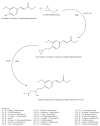Ferulic Acid: A Natural Phenol That Inhibits Neoplastic Events through Modulation of Oncogenic Signaling
- PMID: 36364478
- PMCID: PMC9654319
- DOI: 10.3390/molecules27217653
Ferulic Acid: A Natural Phenol That Inhibits Neoplastic Events through Modulation of Oncogenic Signaling
Abstract
Despite the immense therapeutic advances in the field of health sciences, cancer is still to be found among the global leading causes of morbidity and mortality. Ethnomedicinally, natural bioactive compounds isolated from various plant sources have been used for the treatment of several cancer types and have gained notable attention. Ferulic acid, a natural compound derived from various seeds, nuts, leaves, and fruits, exhibits a variety of pharmacological effects in cancer, including its proapoptotic, cell-cycle-arresting, anti-metastatic, and anti-inflammatory activities. This review study presents a thorough overview of the molecular targets and cellular signaling pathways modulated by ferulic acid in diverse malignancies, showing high potential for this phenolic acid to be developed as a candidate agent for novel anticancer therapeutics. In addition, current investigations to develop promising synergistic formulations are also discussed.
Keywords: anti-angiogenesis; anti-metastasis; apoptosis and cell cycle arrest; ferulic acid; synergism.
Conflict of interest statement
The authors declare no conflict of interest.
Figures




Similar articles
-
Ferulic acid-mediated modulation of apoptotic signaling pathways in cancer.Adv Protein Chem Struct Biol. 2021;125:215-257. doi: 10.1016/bs.apcsb.2020.12.005. Epub 2021 Feb 9. Adv Protein Chem Struct Biol. 2021. PMID: 33931140 Review.
-
Natural Products as Sources of Multitarget Compounds: Advances in the Development of Ferulic Acid as Multitarget Therapeutic.Curr Top Med Chem. 2022 Mar 4;22(5):347-365. doi: 10.2174/1568026622666220117105740. Curr Top Med Chem. 2022. PMID: 35040403 Review.
-
A Comprehensive Review on Therapeutic Applications of Ferulic Acid and its Novel Analogues: A Brief Literature.Mini Rev Med Chem. 2021;21(12):1578-1593. doi: 10.2174/1389557521666210120111702. Mini Rev Med Chem. 2021. PMID: 33494676 Review.
-
The Role of Ferulic Acid in Selected Malignant Neoplasms.Molecules. 2025 Feb 23;30(5):1018. doi: 10.3390/molecules30051018. Molecules. 2025. PMID: 40076243 Free PMC article. Review.
-
Complexation potentiated promising anti-diabetic and anti-oxidative synergism between ZN(ii) and ferulic acid: A multimode study.Diabet Med. 2022 Sep;39(9):e14905. doi: 10.1111/dme.14905. Epub 2022 Jul 6. Diabet Med. 2022. PMID: 35748705
Cited by
-
Temozolomide and flavonoids against glioma: from absorption and metabolism to exosomal delivery.Naunyn Schmiedebergs Arch Pharmacol. 2024 Jan;397(1):41-57. doi: 10.1007/s00210-023-02660-w. Epub 2023 Aug 11. Naunyn Schmiedebergs Arch Pharmacol. 2024. PMID: 37566307 Review.
-
Polyphenols, Alkaloids, and Terpenoids Against Neurodegeneration: Evaluating the Neuroprotective Effects of Phytocompounds Through a Comprehensive Review of the Current Evidence.Metabolites. 2025 Feb 13;15(2):124. doi: 10.3390/metabo15020124. Metabolites. 2025. PMID: 39997749 Free PMC article. Review.
-
Phytochemical and Biological Investigations of Crude Extracts of Astragalus pisidicus.Pharmaceuticals (Basel). 2024 Dec 25;18(1):10. doi: 10.3390/ph18010010. Pharmaceuticals (Basel). 2024. PMID: 39861073 Free PMC article.
-
Ferulic acid as a promising candidate for developing selective and effective anti-cancer therapies.Discov Oncol. 2025 Jul 1;16(1):1214. doi: 10.1007/s12672-025-02294-9. Discov Oncol. 2025. PMID: 40591132 Free PMC article. Review.
-
Effect of Ferulic Acid Loaded in Nanoparticle on Tissue Transglutaminase Expression Levels in Human Glioblastoma Cell Line.Int J Mol Sci. 2024 Aug 1;25(15):8397. doi: 10.3390/ijms25158397. Int J Mol Sci. 2024. PMID: 39125966 Free PMC article.
References
Publication types
MeSH terms
Substances
LinkOut - more resources
Full Text Sources
Medical

